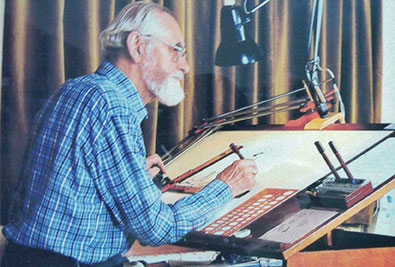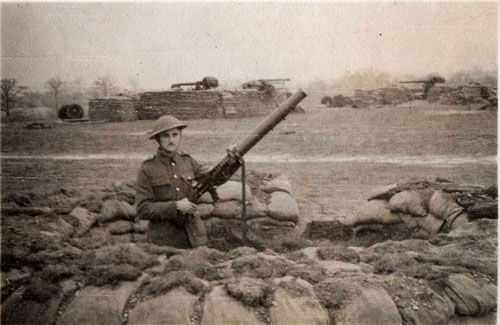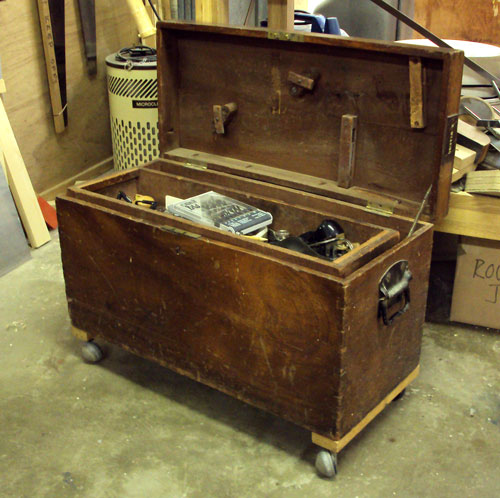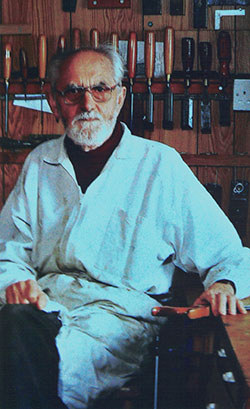Meet the Author: Robert Wearing –

Acclaimed craftsman and woodworking instructor Robert Wearing was formally trained at Loughborough College (now University) in Leicestershire, England. It was there, during the late 1940s, that a physical education teacher said a sentence that Wearing has embraced throughout his long and fulfilling career: “For teacher and pupil, a lesson should be an enjoyable, purposeful activity.”
For Wearing, his childhood lessons in the building of things came from his father, a sailor, and a model construction kit.
Both sides of Robert Wearing’s family came from the south of the United Kingdom’s Lake district. “After WWI my parents married there, but jobs for young officers were hard to find,” Wearing says. “So my father, like the rest of his family went to sea.”
Wearing’s father sailed in Atlantic liners, first to New York and then later to Rio de Janeiro, a six-week voyage. Between trips his father would spend two weeks restocking for the next voyage. The family moved into a house vacated by a family member in the port of Liverpool. This way, when Wearing’s father was on land, he could take the tram home each night to be with the family.
“He was not a craftsman,” Wearing says. “I would call him a useful handyman with tools bought in New York.” Wearing’s father enjoyed building models and mechanical devices with “Meccano,” a model construction system created in their hometown of Liverpool by Frank Hornby. Wearing’s father taught his son how to solder. And while at sea, Wearing’s father would compile lists of parts to convert. “I think I owe a great deal to Meccano, which taught me the basic principles of design,” Wearing says.
Also while at sea, Wearing says his father would design wireless sets, tracing the components on a board and then, once home, build up the circuits. “We had quite a number of sets before manufacturing set up,” Wearing says. “Early ones had headphones. I still remember the first horn-like speaker and its extension to various rooms, including my bedroom when I had a cold.”
Wearing attended a grammar school in Liverpool, learning a variety of subjects, including Latin, German and Spanish, but learned little about woodworking.
When not in school Wearing and his family spent holidays at Windermere in the Lakes. “We wandered the small fells nearby, developing the love of mountain walking,” he says. “When at home there was nothing exciting (to us) to do. I puttered in my little garden shed workshop and began my permanent interest in photography using a Vest Pocket Kodak and processing in the blacked-out bathroom, not popular in my family.”

Wearing served in WWII and after the war, the British government offered a Further Education and Training grant to ex-service personnel, whose training had been interrupted by the war. “Mine had not been but an exception made in the case of teaching,” Wearing wrote in an essay we published here. “There was an acute shortage, since many teachers had been killed and young men were conscripted before they could go to college.”
Wearing visited his old headmaster to inquire about an occupation. “He brought out a copy of every report written, and after perusing these said, ‘You seemed to excel at woodwork. Have you thought of teaching that? It is pleasant work: no preparation, no marking. How little did he know,’” Wearing says.
Wearing’s headmaster summoned a young man who had recently applied for a similar job. Wearing says the man’s advice was short and succinct: “Go to Loughborough. Don’t even think of anywhere else. They will make a craftsman out of you.”
“I like to think they did,” Wearing says, who studied at Loughborough from 1947 to 1950. “This was a pivotal point in my life.”
Wearing wrote in a previous essay that the application to Loughborough required making a teapot stand, “a rather elaborately jointed mitered frame, holding a 6” x 6” ceramic title. I made this in a little garden shed workshop with what tools I had and little knowledge and went for the interview. It was accepted and I was in.”

Before arriving Wearing says he also had to make a dovetailed tool box — three boxes were fitted under each bench.
In those days Loughborough was mostly students studying engineering, and the rest were education — half woodworking and half physical education.
Wearing studied ancient and medieval history, English literature, education, handicraft and technical drawing. His first project from a supplied drawing was a small book rack made from agba, an African hardwood.
“It was a climate of excellent design and high-quality craftsmanship in the company of highly dedicated and motivated fellow students,” Wearing says. “But then we were not normal schoolboy entrants. We were older, some were married and some had children. We had seen the world and not the nicest parts.”
In the workshop, education was informal, and students were left alone to work on their approved drawings. There was a tutor available for consultation. “Each workshop also had a very competent cabinetmaker, who maintained the equipment,” Wearing wrote in his essay. “He was a mine of information and was always most helpful. That was Mr. Finch, who was always referred to as such. Nowadays he would be a technician of varying quality.”
Wearing’s next project was a small mahogany side table with a drawer. Because of timber rationing in the years surrounding the war, finding wood was difficult. But still, students needed wood. In addition to designing and building their own work, they had been tasked with building furniture, designed by renowned craftsman Edward Barnsley, for the college’s proposed library. So the students went to auction sales. A large Cuban mahogany dining table with extending leaves and massive rails proved quite useful. The legs were cut up for turnings. And the table became a paneled bookcase with sliding glass doors. The bottom of railway wagons, destroyed by bombings and deeply embedded with coal and dust, became a source of oak.
“When I took some pieces to the college sawmill, I was rudely sent away to first plane off the top charred ¼”, by hand,” Wearing wrote in his essay. “The boss later relented and agreed to saw and thickness them as the last job before the saw and blades were sharpened. In fact, it proved to be quite nice material, out of which I made several nice pieces in the garage of my hall of residence including a small circular table, which I still have. Also, a small wall hanging bureau.”
All of Wearing’s tutors were former Loughborough students, except for Cecil Gough who was the former foreman of Gordon Russell of Broadway, Gloucestershire. A man by the last name of Ockenden was the head of the department. He trained at Shoreditch College, which Wearing says rivaled Loughborough in terms of excellence. Barnsley gave several lectures and advised students on their individual designs.
Wearing says all the physical education students studied craftsmanship at a lower level and the crafts students studied some physical education. “We were all ex-service men from WWII and so was our physical education tutor who knew full well that we all thought that we had already done enough physical education for a lifetime,” Wearing says. “His slogan, which I have endeavored to follow was, ‘For teacher and pupil, a lesson should be an enjoyable, purposeful activity.’” Another slogan from this teacher? Coach, Correct, Encourage, Praise. “This works for all subjects,” Wearing says. “Although we were craft students, we enjoyed his periods.”
Wearing writes in his essay that there were few machines in the workshops, although they did have a band saw and lathe. He often wished for a circular saw. Wearing’s final project was an oak sideboard, planed by hand from 1” to ¾”.
Years later Wearing visited his son, David, at school. As he entered the school’s workshop Wearing said, “There has been a Lobro (Loughborough) man here.” His son confirmed this. “Though the man had gone, the atmosphere remained. But for how long?” Wearing says. “I wonder.”
After graduation Wearing taught at an independent school. “There was no local authority telling me what to do and what was forbidden,” he says. “I would have resented this by a person who knew less than I did and was a nonperformer.”
Long before computers were common, Wearing set up a press using a 19th-century treadle machine and moveable type. “I had a lot to learn here,” he says. “We printed programs, fixture cards and internal school stationary with some invention.”
Wearing also began teaching individual students at woodturning. “A Chinese girl excelled at this and sent home to her father a pivoting dressing table mirror in English oak with sycamore inlay stringing,” he says. “It arrived intact at Kuda Lampung in Indonesia. He wrote to the headmaster for confirmation that this was made by his daughter, not her teacher. His letter was passed on to me. I was able to confirm and sent a color photograph of her at work on the mirror.”
While teaching Wearing says he made few pieces for clients, who, he says, generally wanted bespoke furniture for factory-made prices.

Wearing excelled as a teacher, and a writer. There’s an ease to which he describes the craft, in words both spoken and written. “Writing is not difficult if you know your stuff and have the opportunity to see your pupils or readers at work,” he says. “My education in English as a boy and as a student was good.”
As for the art of teaching? “The key is conversation,” Wearing says. “Did you ever have a conversation with, say, your math teacher? Children are not good at talking to strange adults, generally because they have nothing to say.” In the workshop, though, Wearing says talking is key. “This is an unnoticed service which the workshop supplies training in conversation skills.”
Wearing found his life purpose after WWII, when his old headmaster suggested teaching craftsmanship. And it’s a vocation he’s enjoyed for more than 50 years. “You must really know your stuff and have a job on the go,” Wearing says. “A head of department told me he never made anything and had no tools but used school tools. Can you imagine a violin teacher who never played for his pleasure and had no violin, but used a school instrument? Or a physical education teacher who had no football boots and could not swim?”
Wearing spent his career not only teaching but also writing about the craft, in magazine articles and books. After owning several cameras, he decided to build one specifically for the technical subjects he was writing about. “This produced 3-1/2” x 2-1/2” color transparencies of good quality,” he says. “Editors liked them so much that they increased my fee. Then disaster struck — digital. Everything had to be digital and I couldn’t make a digital camera.”
Wearing has written a number of books, all now considered classics. They include “Making Woodwork Aids & Devices”, “Hand Tools for Woodworkers: Principles & Techniques” and “The Resourceful Woodworker: Tools, Techniques and Tricks of the Trade”.
In 1988 Wearing published “The Essential Woodworker” with Batsford. For Christopher Schwarz, this book, which he bought on a whim for about $5 in the 1990s, was deeply influential in his study of the craft. “I read the entire book in one siting (it took only a couple hours), but in that short period of time, Wearing assembled all the random puzzle pieces I had collected for years about handwork,” Schwarz wrote in 2010. “He filled in all the missing details about dozens of basic processes, from laying out door joinery to truing up the legs on a table.”
Although it took several years, Schwarz and John Hoffman reprinted the out-of-print book in 2010, and consider it still one of the best books on hand-tool usage written in the post-Charles Hayward era today.
Wearing’s conversation with me was via mail, in handwritten form. He ends his letter with an anecdote:
“I was working one evening when two boys passed the workshop; (it was a boarding school). They saw the lights on and came in. They asked, ‘What are you doing?’ ‘I am going to glue up a drawer.’ ‘Can we watch?’ ‘No.’ Their faces fell. ‘But you can help.’ They found and adjusted the cramps, made and fitted the cramping blocks, tested the diagonals and tested for twist, applied the glue and cramped up. Then we left. Next day they came in and asked, ‘How did it go?’ ‘Have a look it’s under the dust sheet over there.’ They tried the drawer, pushed it in and out, tried it upside down, saying ‘That’s fabulous.’ I said ‘No, that is how it should be and you can do the same if you take care and follow my instructions.’”
For teacher and pupil, a lesson should be an enjoyable, purposeful activity.
Indeed.




